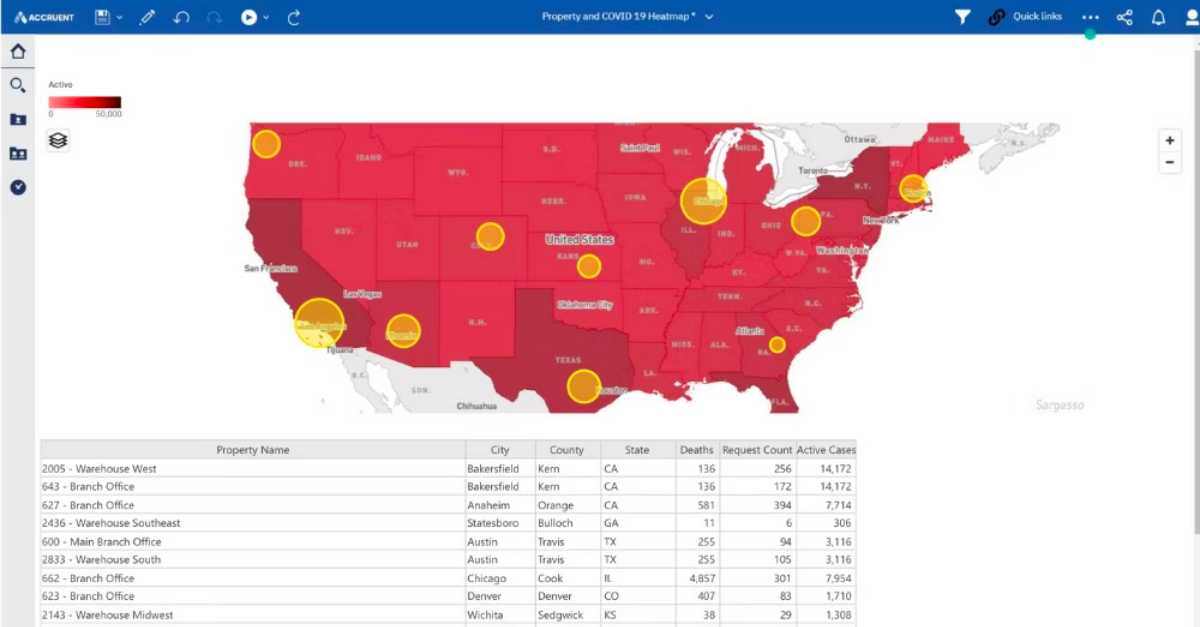
Gain Visibility into the Impact of COVID-19 on Your Portfolio
See how you can combine data from a variety of Accruent applications with enterprise or third-party data sources to derive insights for key business ...
Solutions
Workplace Management Solutions
Real Estate Management Solutions
Maintenance Management Solutions
Energy Management Solutions
Engineering Document Management Solutions
Asset Management Solutions
Automate campus scheduling for classes, meetings, and exams with our EMS software.
Plan and manage conferences effortlessly with EMS software to impress guests and streamline operations.
Boost workplace flexibility and maximize space use with seamless desk and room booking.
Organize workplace or campus events smoothly, creating memorable experiences.
Optimize workspace, manage allocations efficiently, and reduce costs with our space management solutions.
Deliver projects on time and within budget by improving communication, collaboration, and efficiency with our software.
Streamline lease accounting for ASC 842, IFRS, and GASB compliance.
Manage leases efficiently by tracking key dates, analyzing costs, and ensuring compliance.
Centralize data and analytics for better insights, faster negotiations, and revenue growth.
Centralize facility and asset maintenance, automate work orders, and ensure compliance with our CMMS software.
Extend asset life, reduce downtime, and prevent costly repairs with data-driven monitoring.
Prevent equipment failures and extend asset life by detecting and addressing issues early.
Make sustainable, cost-efficient energy decisions by monitoring and optimizing power consumption.
Remotely monitor and control equipment with real-time data to predict issues, boost efficiency, and reduce downtime.
Easily share and collaborate on documents, creating a single source of truth for engineers and contractors.
Manage and analyze assets across their lifecycle to schedule maintenance, reduce downtime, and extend lifespan.
Improve visibility, automate work orders, and ensure compliance for efficient facility and asset management.
Resources
Browse our full library of resources all in one place, including webinars, whitepapers, podcast episodes, and more.
Support
Looking for access to technical support, best practices, helpful videos, or training tools? You’ve come to the right place.
About Accruent
Get the latest information on Accruent, our solutions, events, and the company at large.

Explore business information modeling concepts, BIM data standardize data ownership and how it can benefit your organization.
With governments around the world beginning to mandate business information modeling (BIM) for construction projects, the tool is becoming more important to the industry than ever before. And with good reason: a comprehensive BIM system can simplify the construction, design and management of spaces by providing a single source of truth for decision-making.
Though this is now widely understood and accepted from a construction perspective, the benefits of BIM for owner-operators are less understood. That said, the tool can ultimately lead to marked efficiency improvements throughout the lifecycle of a building or asset, leading to measurable benefits like increased efficiency, better management of spaces, reduced cost, increased ROI and more.
Here, we will walk through basic BIM tools that can be used for operations and management purposes and how to utilize BIM to better manage your space as an owner-operator.
Business Information Modeling or BIM is an intelligent, 3D model-based tool that provides users with a digital representation of the physical and functional characteristics of a facility (Learn more about BIM). The best BIM systems are like ultra-powerful X-rays, providing users with every important detail – from the dimensions of a wall to the location of the electrical, as well as the warranty and technical specs of each wire you may need to repair.
When implemented correctly, this kind of drilled-down information can ultimately solve many construction and maintenance-related communication concerns, providing transparency and a shared knowledge resource that can be used for stronger decision-making throughout a building’s lifecycle.
When construction is complete on a facility or asset, the customer receives a lot of information – including BIM information – from the contractors during the handover process, and they need to save that information for maintenance.
Typically, it’s stored away and only referred to when needed – for example, when an addition is being built or when there’s a repair that needs to be made. The problem? That data doesn’t go through a rigorous discovery, validation and governance process. Instead, it’s stored in an unorganized, overwhelming mish-mash, which makes looking through this information inefficient and time-consuming. This leads to data interoperability losses, high operations and management (O&M) verification costs, and huge delay costs.
Larger facilities like universities and hospitals can spend months to years managing this data, meaning the information is never fully utilized when it’s needed. This is a huge mistake. If properly stored and managed, the asset information in these documents could be crucial for solving consistent facility-related concerns like:
“There’s still no fire extinguisher on the third floor after two years!” “It took six months to figure out what material we needed for this repair!” “Where can we spare some money for repairs?”
These kinds of day-to-day queries – which can drain both patience and money – can be easily answered if a robust BIM is used for O&M. This requires that a systematic handover of organized BIM data replace the current unorganized handover process. It also requires the use of the industry foundation class (IFC) format so that all relevant personnel can add and access information without loss or distortion of that data.
Though this may be more work up-front, having a single source of truth for asset data also means massive cost and efficiency savings down the line – and these pros massively outweigh the cons.
Years ago, Shell corporation ran into a big problem: they had a ton of data, but they couldn’t do anything with it. Why? There was no standardization when it came to referring to data in the oil and gas industry, so it was nearly impossible to share or standardize the important data they had on hand.
Say, for example, that you need to count how many toilets are in a space, but you’re in a group where one person calls it a toilet, another a loo, a third the privy, and so on – and no one knows what the other one means when they use their word of choice or how to search for the item in the system. It’d be impossible to even get a comprehensive search going, let alone an accurate and usable number of toilets.
Well, for the oil and gas sector, this kind of inconsistency in naming was creating huge communication and financial concerns. The industry responded to this issue by developing an industry standard for data handover called CFIHOS. CFIHOS ultimately provided a single source of truth for all business-critical information, thereby improving communication and operations.
And it worked, providing a single tool that owners, operators, construction workers, and all other relevant personnel could refer to as a guide for standardizing important data. This ultimately led to significant benefits, including:
BIM has the potential to allow users to create a CFIHOS-like reference data library for the construction and facilities management industries. This kind of standardization doesn’t currently exist in the facilities management industry.
As a start, you can use BIM within your company to standardize naming and data reference in your business, thereby gaining an edge over your competition. Eventually, this will evolve into an industry-wide standard.
The asset structure refers to all the components of an asset or building – walls, doors, doorknobs, etc. After the construction phase on a building is completed, the asset breakdown structure, or the document that houses all of this information, will be released. This document is crucial both during and after the construction process: during construction, construction companies need access to precise details like what reinforcement is in the walls.
Similarly, during operations and maintenance, you need this information to complete repairs, maintenance, or additions. In some areas, you don’t need the same out of detail that construction companies need, but in others immense detail can help. For example, if you’re repairing an HVAC system, it’s helpful to know the details of the unit, including the spare parts list, the electrical, the power distribution, the location of the fuse boxes, etc. Otherwise, it could be a costly and inefficient repair.
Once you have your asset breakdown information organized, you can set up a cost breakdown structure for ongoing maintenance. For example, if you run a university, you can break down what rooms will be used, who’s using those rooms, what work needs to be done for maintenance, and who’s paying for that maintenance.
Without a BIM system, it’s difficult to establish those relationships and understand who’s using what space and who is fiscally responsible – and this could lead to both inefficiency and financial losses over time.
Effectively establishing this relationship allows you to budget and ultimately save both money and headache.
The work breakdown structure allows you to look directly at work orders so you can establish how work relates to various areas.
Say, for example, that you have a work order to work on an HVAC. Well, you can notify the users in those rooms that there will be a disruption on certain dates and times. You can also restrict access. For example, you can control key management if, say, you run a hospital and there’s a pharmacy that you want to limit access to.
This kind of control and preemptive information can streamline the work order process, save time, and help ensure that all personnel in a building are updated and able to effectively respond to what’s going on.
In an asset breakdown structure, there is more than one hierarchy. For example, you could have one view that talks about the building, floor and details of the room, and another view that discusses the details of the building’s HVAC units. This can be more helpful than you realize.
If you want to effectively complete maintenance, you need to have access to the best way of looking at the information you need, and you need to understand all relevant information.
If, for example, you get a work order that states that a light and a PC don’t work in a particular room, you have the schematics you need to know exactly which fuse box is blown and where to go in the walls to fix the problem.
If you’re an owner-operator with a new building, you need to set up your facilities management system. This means that you need to set up artifacts in your maintenance management system, including:
Using a BIM in facilities management is not common practice, and it is always difficult and time-consuming to implement new technology. That said, the pros of doing so dramatically outweigh the cons, and a BIM system can ultimately be used alongside your existing facility management tools – like Accruent’s FAMIS 360 and Maintenance Connection – to save money and streamline your operations.
Watch this on-demand webinar to learn more about how you can use BIM in your facilities management.
See how you can combine data from a variety of Accruent applications with enterprise or third-party data sources to derive insights for key business ...
Learn how Accruent Data Insights standardizes medical device categories so that your healthcare organization’s data is more consistent and useful.
See how Seattle City Light Utilities implemented Meridian EDMS to attain document versioning control and data integrity over its 100 years’ worth of ...
Subscribe to stay up to date with our latest news, resources and best practices